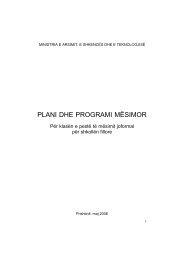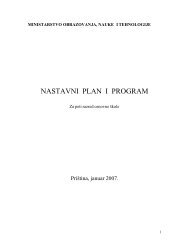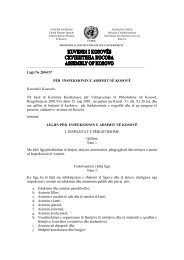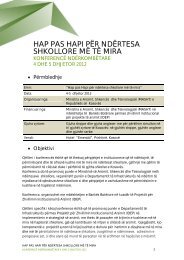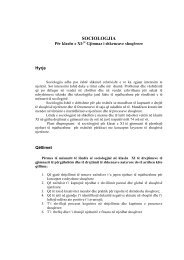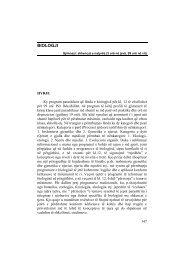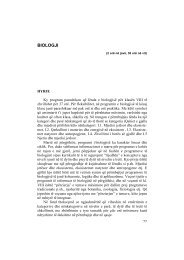Humboldt Kosmos 90/2007: Wissen schafft Entwicklung
Humboldt Kosmos 90/2007: Wissen schafft Entwicklung
Humboldt Kosmos 90/2007: Wissen schafft Entwicklung
Sie wollen auch ein ePaper? Erhöhen Sie die Reichweite Ihrer Titel.
YUMPU macht aus Druck-PDFs automatisch weboptimierte ePaper, die Google liebt.
<strong>Wissen</strong> <strong>schafft</strong> <strong>Entwicklung</strong> | || From Knowledge to Development <strong>Wissen</strong> <strong>schafft</strong> <strong>Entwicklung</strong> | || From Knowledge to Development<br />
Mineralstoffe der optimale Boden enthalten muss, er kennt die<br />
Konzentration der verschiedenen Nährstoffe, die die Früchte<br />
ernährungsphysiologisch so attraktiv machen. Er weiß, wie viel<br />
Sonnenlicht die Pflanze für optimales Wachstum braucht und dass<br />
sie gegen Schädlinge und Pilze unempfindlich ist. Die Schlangentomate<br />
verträgt auch starke UV-Belastungen, wie Adebooye sie<br />
mit künstlicher Bestrahlung an einigen Pflanzen simuliert hat.<br />
Europäische Obst- und Gemüsearten reagieren unter solchen<br />
Bedingungen empfindlicher. Sie bekommen einen Sonnenbrand.<br />
Welche Schutzmechanismen dafür sorgen, dass der Schlangen-<br />
„Allenfalls Rosenzüchter können wirklich das<br />
Glücksgefühl nachvollziehen, das sich einstellte,<br />
als endlich die ersten Früchte sprossen.“<br />
tomate so etwas nicht passiert, interessiert nicht nur Adebooye,<br />
sondern auch seinen wissenschaftlichen Gastgeber und Leiter<br />
des Fachbereichs, Georg Noga. Wie Pflanzen auf Stress reagieren<br />
und wie sie trotzdem hohe Erträge liefern, ist einer seiner Forschungsschwerpunkte.<br />
Die Erforschung der Schlangentomate<br />
könnte ihm Erkenntnisse liefern, die sich bei der Züchtung neuer,<br />
sonnenbrandunempfindlicherer Nutzpflanzen einsetzen ließen.<br />
„Oft höre ich, dass <strong>Wissen</strong>schaftler aus <strong>Entwicklung</strong>sländern<br />
nur hierher kommen, um bei uns etwas zu lernen. Die klassische<br />
<strong>Entwicklung</strong>shilfeeinbahnstraße sozusagen. Doch bei diesem<br />
Projekt findet es statt, das viel beschworene Geben und Nehmen.<br />
Die Zusammenarbeit führt zu einem <strong>Wissen</strong>sgewinn auch auf<br />
unserer Seite!“, sagt Noga. Er leitet den Lehr- und Forschungsbereich<br />
Gartenbauwissenschaft im INRES schon seit rund zehn<br />
Jahren. Mit grauen Haaren, Anzug und Schlips entspricht er dem<br />
seriösen Bild, das man sich wohl nicht nur in Nigeria von einem<br />
deutschen Professor macht. Adebooye spricht ihn nur mit Prof an,<br />
beinahe so, als wäre er selbst noch ein Student und als erfordere<br />
dies der Respektabstand, den ein 40-jähriger <strong>Wissen</strong>schaftler aus<br />
einem <strong>Entwicklung</strong>sland zu einem deutschen Professor zu halten<br />
habe. Doch wenn Adebooye Prof sagt, hört es sich nicht nur nach<br />
Respekt, sondern zugleich nach Vertrautheit an. Sein Gastgeber<br />
und er sind ein Team.<br />
Welchen Respekt er tatsächlich vor der Erfahrung und dem<br />
Know-how des deutschen Kollegen hat, betont Adebooye mit<br />
Nachdruck. Dankbar sei er für das, was er hier lernen und für die<br />
ungleich besseren Bedingungen, unter denen er forschen könne.<br />
Die Begeisterung ist gegenseitig. „Am liebsten“, sagt Noga, „würde<br />
ich ihn hierbehalten. Er ist ein hervorragender <strong>Wissen</strong>schaftler.“<br />
In wenigen Wochen endet die Kooperation leider vorzeitig. Adebooyes<br />
Heimatuniversität hat ihn wegen Personalmangels im<br />
Lehrbetrieb zurückgerufen. Die geplanten gemeinsamen Versuche<br />
zur UV-Resistenz der Pflanze muss Noga nun allein mit<br />
seiner Kollegin Christa Lankes durchführen, die schon die bis-<br />
susceptible to pests and fungi. The snake tomato can also withstand<br />
strong UV exposure as Adebooye demonstrated by a simulation<br />
with artificial irradiation on some of the plants. European<br />
fruit and vegetable varieties react much more sensitively under<br />
the same conditions. They get sunburnt.<br />
“At best rose-growers can really<br />
imagine the utter happiness of seeing<br />
the first fruit actually sprouting.“<br />
What the protective mechanisms are that prevent this from happening<br />
to the snake tomato is something that doesn’t only interest<br />
Adebooye but also his academic host and head of department,<br />
Georg Noga. How plants react to strain and produce a high yield<br />
nonetheless is one focus of his research. Investigating the snake<br />
tomato could enable him to gain insights which might be utilised<br />
in the cultivation of new agricultural crops that are less susceptible<br />
to sunburn. “I often hear people saying that scientists from<br />
developing countries only come here to learn something from<br />
us – classic one-way street development, so to speak. But in this<br />
project the give and take people are always talking about really is<br />
taking place. Cooperation is increasing knowledge on our side,<br />
too,” Noga claims. He has been head of the Division of Horticultural<br />
Sciences at INRES for roughly the last ten years. With<br />
his grey hair, formal suit and tie he is the epitome of the serious<br />
German professor, and not just from a Nigerian perspective.<br />
Adebooye always addresses him as Prof, just as though he himself<br />
were still a student and as though respectful distance were<br />
what was expected from a 40-year-old scientist from a developing<br />
country towards a German professor. But when Adebooye says<br />
Prof it doesn’t only seem to signal respect but intimacy, too. He<br />
and his host are a team.<br />
The degree of respect he really has for his German colleague’s<br />
experience and know-how is something Adebooye is quick to<br />
emphasise. He is thankful for what he can learn here and for the<br />
incomparably better conditions for his research work. The enthusiasm<br />
is mutual. “Ideally, I’d like him to stay here,” Noga comments.<br />
“He’s an outstanding scientist.”<br />
Unfortunately, the collaboration will be curtailed in just a few<br />
weeks. Adebooye’s own university has called him back because<br />
they are short of teaching staff. The joint experiments they had<br />
planned on the plant’s UV resistance will have to be carried out<br />
just by Noga, together with his colleague Christa Lankes who has<br />
already been closely involved in the experiments so far. Adebooye,<br />
on the other hand, will take up where he left off in Nigeria after he<br />
had discovered the plant in a small village and started investigating<br />
its potential. At the time, he organised a scientific conference<br />
and launched his advertising campaign. Every participant was<br />
given a packet of seeds and started cultivating the snake tomato<br />
Snack im Gewächshaus: Adebooye, Gastgeber Noga<br />
und Kollegin Lankes kosten die ersten Früchte. | ||<br />
Snack in the hothouse: Adebooye, host Noga and<br />
colleague Lankes try the first fruits.<br />
herigen Experimente tatkräftig begleitete. Adebooye<br />
wird dagegen dort weitermachen, wo er in<br />
Nigeria aufgehört hat, nachdem er die Pflanze in<br />
einem kleinen Dorf entdeckt und ihr Potenzial zu<br />
erforschen begonnen hatte. Damals hatte er eine<br />
wissenschaftliche Konferenz veranstaltet und die<br />
Werbetrommel gerührt. Jeder der Teilnehmer<br />
bekam ein Päckchen mit Samen, um die Schlangentomate in seiner<br />
Region anzubauen. Mit den Ergebnissen aus Bonn plant Adebooye<br />
nun die nächste Welle zur Verbreitung der Pflanze.<br />
Doch noch ist es bis zum Abschied einige Zeit hin. Gemeinsam<br />
sitzen Adebooye, Noga und Christa Lankes in Nogas Büro und<br />
feiern einen ganz besonderen Augenblick: Die erste Schlangentomate<br />
aus Bonner Zucht kommt auf den Tisch. Adebooye schneidet<br />
sie mit einer Rasierklinge der Länge nach auf und serviert<br />
die tiefroten fleischigen Kerne auf dem herbeigeholten Kaffeegeschirr.<br />
Sie schmecken süßlich exotisch und erinnern an eine<br />
Kakifrucht. „Nicht schlecht. Aber der Geschmack ist sicher noch<br />
ausbaufähig“, meint Noga. Ob die Schlangentomate auch etwas<br />
für den deutschen Küchentisch wäre, müssten die Konsumenten<br />
entscheiden. Nogas Institut arbeitet mit einem Partner zusammen,<br />
der sich um die Vermarktung neuer und optimierter Nutzpflanzen<br />
kümmert. Vielleicht liegt Trichosanthes cucumerina L.<br />
also irgendwann einmal im Regal des Supermarkts um die Ecke.<br />
Möglicherweise dann an Stelle der hierzulande weit überschätzten<br />
gemeinen Strauchtomate. Odunayo Adebooye wäre sicher sehr<br />
stolz auf sein Baby. n Von Georg Scholl<br />
Dr. Odunayo Clement Adebooye lehrt pflanzenphysiologie<br />
und Agrarwissenschaften an der<br />
Obafemi Awolowo university, IleIfe, Nigeria.<br />
Als Georg forsterforschungsstipendiat war er<br />
<strong>2007</strong> an der universität Bonn. zuvor forschte er<br />
von November 2005 bis Juni 2006 am central<br />
food Technological research Institute der<br />
universität der Vereinten Nationen in Mysore,<br />
Indien.<br />
in his or her own region. Using the Bonn results Adebooye is now<br />
planning the next stage of plant dissemination.<br />
But there is still a while to go before he has to say goodbye. Adebooye,<br />
Noga and Christa Lankes are sitting together in Noga’s<br />
office celebrating a special moment. The first snake tomato grown<br />
in Bonn is about to be served. Adebooye cuts it lengthwise with<br />
a razor blade and places the deep red, fleshy kernels on the plates<br />
usually used for biscuits. They taste exotically sweet and are reminiscent<br />
of kaki fruit. “Not bad. But the flavour certainly leaves<br />
room for development,” Noga comments. Whether the snake<br />
tomato ends up on kitchen tables in Germany is something consumers<br />
will have to decide. Noga’s institute works together with<br />
a partner who deals with the marketing of new and improved<br />
agricultural crops. So maybe Trichosanthes cucumerina L. will be<br />
found on the shelves of the supermarket round the corner at some<br />
stage. Perhaps instead of what is vastly over-rated in this country<br />
– the common vine tomato. Odunayo Adebooye would certainly<br />
be very proud of his baby. n By Georg Scholl<br />
Dr. Odunayo Clement Adebooye teaches plant<br />
physiology and agricultural science at Obafemi<br />
Awolowo university, IleIfe, Nigeria. In <strong>2007</strong>, he<br />
was a Georg forster research fellow at Bonn<br />
university and from November 2005 to June<br />
2006 conducted research at the central food<br />
Technological research Institute at the united<br />
Nations university in Mysore, India.<br />
22 <strong>Humboldt</strong> kosmos Sonderausgabe 2008<br />
23



